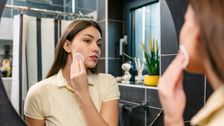It happens to the best of us: Sometimes, we can’t help but pop a pimple, a whitehead or a blackhead. Although tempting, dermatologists recommend that you refrain from touching or squeezing acne spots.
“Popping is bad because it makes the entire area more red and inflamed, making it take longer to heal,” Dr. Jason Chouake, a dermatologist at the American Academy of Dermatology, told HuffPost. “It increases your risk of deeper infection and scarring, which can be permanent.”
Nicole Olsen got such an infection after popping a pimple on her face. The Miami woman, who works in a medical office, then turned to povidone-iodine, which is commonly used before and after surgery.
In a TikTok video documenting her experience, she’s seen applying the orange-brown solution to her face with a cotton swab. Olsen said she used it to deal with acne and scarring.
“Within a few hours, I felt improvement in terms of inflammation and pressure in the area, so I reapplied and continued to spot-treat through the night,” Olsen told HuffPost. “The next day, the scab began to almost flake off from healing over so quickly. I was amazed there wasn’t even a mark left behind like my usual scarring from a bad pimple pop.”
Olsen’s not the only one looking to povidone-iodine ― sometimes called just iodine ― as an acne treatment. Her TikTok garnered 1.2 million views, with many people leaving comments about how the solution is used in various countries and cultures.
“In Armenian households, it’s common to use iodine when sick with a sore throat or with a cough or cold. They use the iodine swab to draw a grid on either the throat, chest and back,” Olsen said. “We had people from Armenia, Philippines, Poland and Mexico confirm they do this as well.”
As for its use on pimples, dermatologists are not surprised that the antiseptic can result in clearer skin. However, people who’ve heard about the TikTok trend should be aware of some risks. Before you introduce the solution into your skin care regimen, here’s what the experts say you should know.
Povidone-iodine reduces bacteria, so it could have some acne-busting benefits.
Iodine has been preventing infections for over 150 years. You might have seen iodine solutions featured in hospital shows; they’re often used by doctors at the operating table or while scrubbing in. The disinfectant can be used in skin preparation for nonsurgical procedures as well.
Povidone-iodine is available over the counter in different forms, including liquid, dry powder spray and ointment. The main purpose of topical solutions is to treat small cuts, burns and scrapes.
“When povidone-iodine dries on the skin, it works as a disinfectant by rapidly penetrating into bacteria and other microorganisms, oxidizing key proteins and fatty acids, causing the death of those microbes,” Chouake said. “The fact that it works so quickly to kill those microbes is why it’s used to clean the skin before surgeries ― to prevent infection.”
Generally, antiseptics contain chemicals called biocides that are used to kill and control the growth of some organisms. Povidone-iodine can remove bacteria in a matter of minutes or even seconds.
“It reduces bacteria on the skin, which can lead to improvement of acne,” Chouake said. “It’s well known that topical antibiotics and washes can improve acne. That’s why so many people use benzoyl peroxide, clindamycin and sulfur washes to help improve their acne.”
Before you add iodine to your skin care routine, here are a few warnings.
Although povidone-iodine is typically safe to use, Dr. Jaishree Sharad, a cosmetic dermatologist at Skinfinitii Aesthetic Skin and Laser in India, told HuffPost that it shouldn’t be applied regularly.
“One may develop irritation to povidone-iodine,” Sharad said, adding that it should be an “SOS treatment for a day or two only, if nothing else is available.”
Additionally, the solution might cause hyperpigmentation, a condition in which patches of skin become darker than the surrounding areas. This may present as freckles or age spots.
“Popping pimples can damage skin further and result in post-inflammatory hyperpigmentation, especially in skin of color,” Sharad said. “It can lead to secondary bacterial infection.”
Although the solution can help disinfect the skin, it’s important to test any product before using it.
“There is also a very good reason we never recommend iodine,” Chouake said. “Povidone-iodine is not meant to be left on the skin for extended periods of time. It has to be washed off, or it can cause severe contact dermatitis.”
Allergic contact dermatitis occurs when the immune system reacts to certain substances, even in small amounts. Contact allergies can result in a red rash, swelling, and itchy or dry skin. So, you may want to be careful before applying it all over your face.
“There is not a board-certified dermatologist alive who has not seen contact allergy to iodine. It is well known,” Chouake said. “This is why I would always caution people not to randomly use medical supplies on your skin, which to some might seem self-evident.”
Instead, if you’re looking for a way to prevent acne or a bacterial infection from a popped pimple, Chouake recommended topical medications and antimicrobials that keep pores clear.
“I love gentle benzoyl peroxide washes, or hypochlorous acid washes or sprays,” he said.


